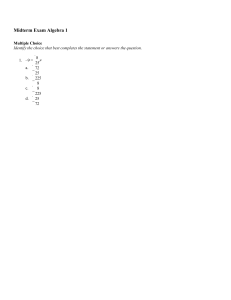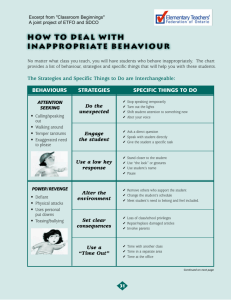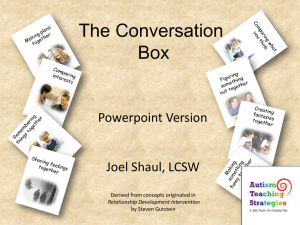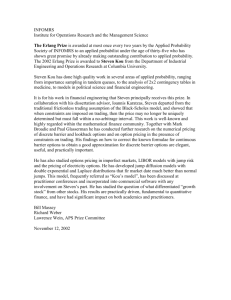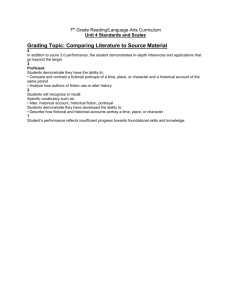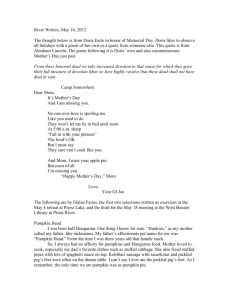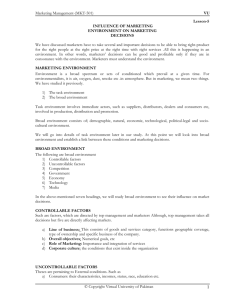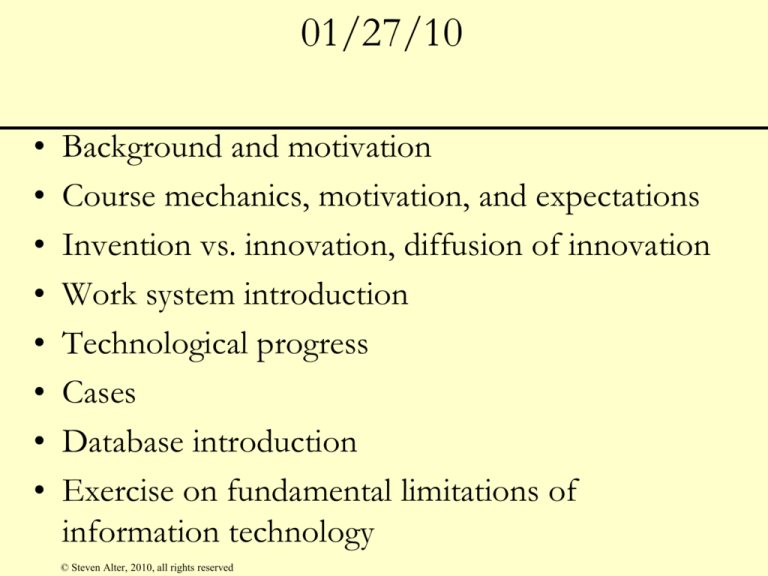
01/27/10
•
•
•
•
•
•
•
•
Background and motivation
Course mechanics, motivation, and expectations
Invention vs. innovation, diffusion of innovation
Work system introduction
Technological progress
Cases
Database introduction
Exercise on fundamental limitations of
information technology
© Steven Alter, 2010, all rights reserved
My background and motivation
• Taught at USC
• Vice President of Consilium
– Manufacturing software start-up in Silicon Valley.
– Acquired by Applied Materials
•
•
•
•
Return to university – How can I contribute best?
Information systems textbook (4 editions)
Recent research and book (Work System Method)
www.stevenalter.com
© Steven Alter, 2010, all rights reserved
Mechanics of Course
• Blackboard site
• Daily assignments
– Reading assignments (Look at the questions first.)
– 5 work system snapshot assignments due before class on Tuesday
• Graded assignments
–
–
–
–
Group: Emerging technology paper (2/17)
Group: Work system innovation paper (3/10)
Individual: Take-home final exam (3/10)
Individual: 5 work system snapshot assignments (2/3, 2/10, 2/17, 2/24, 3/3)
• Subject line when sending emails …
– Last name, first name, assignment name
– Title of paper, list of team members
© Steven Alter, 2010, all rights reserved
Templates for Major Papers are
Available on Blackboard
• Templates support learning.
• Templates clarify expectations.
• Templates make it easier to evaluate papers.
© Steven Alter, 2010, all rights reserved
Paper and Electronic
• Both paper AND electronic versions, submitted to
alter@usfca.edu
– Group: Emerging technology paper
– Group: Work system innovation paper
– Individual: Take-home final exam
• Electronic only, submitted to alter@usfca.edu
– Presentation for Emerging technology paper
– Presentation for Work system innovation paper
• Electronic only, submitted through the Assignment page on
Blackboard
– Individual: 5 work system snapshot assignments
© Steven Alter, 2010, all rights reserved
Expectations during class
• Submit work system snapshot assignments
before class using the Blackboard
Assignments page
• We will discuss reading assignments and work
system snapshot assignments during class
• Frequently break into smaller groups
– Move around as necessary.
• Interactive learning as much as possible
• No right answer in many situations
© Steven Alter, 2010, all rights reserved
Invention vs. innovation
• Invention
– The first occurrence of an idea for a new product or
process
• Innovation
– The successful introduction of a new thing or method
that adds value.
– Ideas applied successfully.
– May be incremental, radical, or revolutionary.
– May also have a negative or destructive effect as new
developments clear away or change old organizational
forms and practices.
© Steven Alter, 2010, all rights reserved
Diffusion of innovation curve
(Everett Rogers)
© Steven Alter, 2010, all rights reserved
Sources of innovation
• Inventors and R&D
• Entrepreneurs/ marketers
• End-user innovation (von Hippel)
– Difficulties in using the product
– Adaptations of the product
• Managers looking for better performance
© Steven Alter, 2010, all rights reserved
Technology-Enabled Innovation
• Relies on technology, but may not be about
technology
• Changes a system of doing work
• The innovation is a work system innovation
• The process of innovating is the process of
changing the IT-reliant work system.
© Steven Alter, 2010, all rights reserved
Importance of tech-enabled innovation
to general managers
• Want better business results
– Cash, profitability, market share, ROA, etc.
• Business results come from operational results
– Efficiency, speed, consistency
• Operations occur through IT-reliant work systems
• ==>>> Better business results occur through
Technology-Enabled Innovation
© Steven Alter, 2010, all rights reserved
We will focus on work system innovations
that apply information technology
• Permits focus in a short course.
• Three-fer
– Learn about IT in practice
– Learn about organizational operations
– Learn about innovation in organizations
• Will not discuss many important types of
inventions in physical technologies: solar, wind,
battery, pharmaceuticals etc.
© Steven Alter, 2010, all rights reserved
This Course’s Central Issue for
Managers and Business Professionals
• How can I be more effective in evaluating systems and
thinking about how to improve them, whether or not IT plays
a major role, and whether or not the system is totally within
my organization or links to other organizations?
• Why is this important?
–
–
–
–
Assume you are a manager or executive.
Assume you are a sales professional.
Assume you are an IT professional.
Assume you are an entrepreneur.
© Steven Alter, 2010, all rights reserved
The Work System Method: Connecting
People, Processes, and IT for Business Results
• The big picture for understanding systems in
organizations
• Drill down into work system elements
• Lots of business terms for understanding and
analyzing systems
© Steven Alter, 2010, all rights reserved
Work System Framework
© Steven Alter, 2010, all rights reserved
Typical Work Systems at USF
•
•
•
•
•
•
USF’s system for accepting students
USF’s system for registering for classes
USF’s system for assigning classes to classrooms
USF’s system for paying employees
USF’s system for long term planning
USF’s system for recruiting athletes
© Steven Alter, 2010, all rights reserved
Work systems use IT,
but aren’t IT systems.
Typical work systems analyzed by
students at Georgia State
Renewing insurance policies
Determining salary
increases
Operating an engineering call
center
Timekeeping for field
technicians for a public
utility
Scheduling and tracking
health service
appointments
Determining govt. incentives
for providing employee
training
Receiving materials at a large Planning/dispatching
warehouse
trucking services
Finding and serving sales
consulting clients
Controlling marketing
expenses
Invoicing for construction
work
Administering budgets for
grants
Performing pre-employment Collection/ reporting of
background checks
sales data for a wholesaler
Performing financial planning
for wealthy individuals
Approving real estate loan
applications
Acknowledging gifts at a
charity organization
© Steven Alter, 2010, all rights reserved
Purchasing advertising
services
Special Cases of Work System
•
•
•
•
Information System
Project
Supply Chain
E-commerce web site
© Steven Alter, 2010, all rights reserved
© Steven Alter, 2010, all rights reserved
Metrics: Quantitative measures for
evaluating performance
• When analyzing a work system, use
information such as
Metric
Current value
Realistic goal
Speed (cycle time)
9 days from start to finish
5 days
Person hours/ unit
12 person hours/ unit
8 person hours/ unit
Error rate
15%
10%
Customer satisfaction
6.2 out of 7
6.7 out of 7
• What are 10 possible metrics for evaluating
the hiring system?
© Steven Alter, 2010, all rights reserved
Assignment 2.1
• Produce a work system snapshot for Apple’s
process of accepting new apps for sale in the
Apple Store
• Submit before class on Feb. 3
• Grading method is on the assignment
© Steven Alter, 2010, all rights reserved
Evaluating a work system snapshot
• Fig. 2.2, p. 17
• Explain why this is or is not a good work
system snapshot.
© Steven Alter, 2010, all rights reserved
Characteristics of a good work system
snapshot?
• Describes the relevant work system
– The smallest work system that has the problem
or opportunity that is being analyzed
• No more than one page
• Internal consistency: See Guidelines in
WSM, p. 48.
© Steven Alter, 2010, all rights reserved
Explain why the following is or is not
a good work system snapshot
Customers
* Applicant
*
Products & Services
* Loan
*
Major Activities or Processes
* Find applicants
* Produce loan application
* Approve or decline
* Send paperwork
Participants
Information
* Applicant
* Application
* Loan office *
*Committee *
© Steven Alter, 2010, all rights reserved
Technologies
* Telephone
* Spreadsheet
* Word processor
Parts of an analysis and design effort
• What work system are we talking about?
– Work system snapshot
• How well does it operate?
– Metrics
• How do work systems change?
– Work system life cycle model
© Steven Alter, 2010, all rights reserved
Project Success Rates from Surveys
© Steven Alter, 2010, all rights reserved
Work System Life Cycle Model (Chap. 7)
Operation &
Maintenance
Implementation
© Steven Alter, 2010, all rights reserved
Initiation
Development
Demonstrate the presence of
technological progress
• Identify 10 devices or tools that are
commonplace today, but didn’t exist or were
barely on the radar screen 10-15 years ago.
© Steven Alter, 2010, all rights reserved
What does IT do?
•
•
•
•
•
•
Capture information
Transmit information
Store information
Retrieve information
Manipulate information
Display information
© Steven Alter, 2010, all rights reserved
IT hides essential details users don’t care
about. (See WSM, Chap. 13, pp. 179-192)
• Intentionally or not, it may hide, obscure, or
misrepresent threats to personal and
organizational interests.
–
–
–
–
–
Surveillance
Unexpected storage of information
Unexpected use of information
Lock-in
Hidden assumptions and logic
© Steven Alter, 2010, all rights reserved
Better technology may NOT help
• When and why?
• In business situations, how can one judge
whether a particular technology is better?
© Steven Alter, 2010, all rights reserved
IT often encounters or causes problems
• Look at one of the following articles on Blackboard
–
–
–
–
Password problems
Distractions related to technology
Skype outage
Difficulty correcting public data
• Comments to class about the article you read
– What is the main point of the article?
– What management, business, or societal trade-offs are
related to the problem or issue in the article?
© Steven Alter, 2010, all rights reserved
Moore’s law in action: memory chips
•
•
•
•
•
•
•
•
•
•
•
1973
1 kilobit
1,024
1976
4 kilobit
4,096
1979
16 kilobit
16,384
1982
64 kilobit
65,536
1985
256 kilobit
262,144
1988
1 megabit
1,048,576
1991
4 megabit
4,194,304
1994
16 megabit
16,777,216
1997
64 megabit
67,108,864
2000
256 megabit
268,435,456
Flash drives: 64 gigabyte or more
© Steven Alter, 2010, all rights reserved
Progress in microprocessors
•
•
•
•
•
•
•
•
•
•
•
•
•
•
chip
year
transistors addressing MIPS
4004
1971
2,300 4 bit
0.06
8080
1974
3,500 8 bit
0.06
8086
1978
29,000 16 bit
0.3
286
1982
134,000 16 bit
0.9
386
1985
275,000 32 bit
5.
486
1989 1,300,000 32 bit
20.
Pentium
1993 3,200,000 32 bit
100.
Pentium Pro 1995 5,500,000 32 bit
300.
Pentium II
1997 8,000,000 32 bit
500.
Pentium III
1999 28,000,000 32 bit
1,000.
Pentium IV
2000 42,000,000 32 bit
1,500.
Itanium
2000 25,000,000 64 bit
--2008 view: http://download.intel.com/pressroom/kits/IntelProcessorHistory.pdf
© Steven Alter, 2010, all rights reserved
Telecomm data transfer rates
•
•
•
•
•
•
•
•
•
Year
1844
1876
1915
1940
1956
1983
1996
2000
Data rate
5 bps
2 Kbps
30 Kbps
7.6 Mbps
1.3 Mbps
45 Mbps
2.5 Gbps
3280 Gbps
© Steven Alter, 2010, all rights reserved
technology
telegraph
telephone
Transcontinental cables
Coaxial telephone cable
Transatlantic telephone cable
First fiber optic trunk line
Install faster fiber cables
Bell Labs - 300 km cable in lab
Moore’s
Law is
the fifth
IT gen.
© Steven Alter, 2010, all rights reserved
Back to current reality
• For each of the following cases:
– What happened?
– What might have helped avoid the problem?
– Is the situation related to an IT-enabled
innovation?
• Cases
– Comair
– Mizuho
– Click fraud
© Steven Alter, 2010, all rights reserved
Rate yourself on a scale from 1-5
• 1 – My professional roles use IT knowledge and
focus on building, analyzing, or maintaining IT
systems
• 2 - My professional roles involve extensive use of
IT systems and knowledge of IT
• 3 - I have used IT systems extensively, but my roles
are not associated with IT
• 4 – I use IT occasionally, and often joylessly.
• 5 – I am allergic or semi-allergic to IT.
© Steven Alter, 2010, all rights reserved
Emerging technology assignment –
due on Feb. 17
• Teams of 4 – with one or two 3’s
• Assignment 2.2: Email by Feb. 3 : team members and
one paragraph about proposed topic.
– What is the technology (or group of related technologies)
– Why it is interesting or important
• Technology of type whose application business people
can understand (not hidden in infrastructure)
© Steven Alter, 2010, all rights reserved
Examples of possible topics
•RFID for
inventory/ asset
tracking
•WI-MAX
•Speech
recognition
•Augmented
reality
•Software as a
service
•Sensor networks •Biometrics, face •Flexible display
(smart dust)
recognition
screens
•RFID for
•Virtualization
identifying
people
•Advanced video •Tablet PCs
conferencing
•Automatic
translation
•Semantic web
•eBooks
•Alternate forms •Telemedicine
of cash
•Text mining
•Real world
applications of
virtual worlds
•Intelligent
surfaces
© Steven Alter, 2010, all rights reserved
Emerging technology assignment
(details)
• Identify sources
• Between 5 and 8 pages
– Single spaced in the format of the template
• Brief presentation to class
© Steven Alter, 2010, all rights reserved
Gartner Hype Cycle for 1995
http://www.gartner.com/DisplayDocument?doc_cd=130115
© Steven Alter, 2010, all rights reserved
Gartner’s Emerging Technologies, 2005
http://www.gartner.com/DisplayDocument?doc_cd=130115
© Steven Alter, 2010, all rights reserved
Possible starting point
• http://www.gartner.com/DisplayDocument?doc_cd=
130115
• Find an interesting hype cycle on the Gartner web site (Should
involve applications rather than pure technology)
• Find the outline of a Gartner Hype Cycle Report that is being
sold for $$$
• Identify interesting topics that are mentioned in the outline
• Use web searches and other sources to find information about
interesting topics.
• If you can’t find any info, select a different topic.
© Steven Alter, 2010, all rights reserved
Database Introduction
• What does a database look like?
• What are the advantages of using database
software?
• Northwind Traders - a hypothetical
distributor of gourmet food products
• Great example of a database application
– Not trivial, but not too complicated
– Master date is filled in
– Transaction data is filled in
© Steven Alter, 2010, all rights reserved
Database exercise using a spreadsheet
as a database
• Download the Excel database from
Blackboard
• Add a new product
• Add a new customer
• Enter an order for the new customer.
– 12 units of Grandma’s Boysenberry Spread
– 16 units of Tofu
– 25 units of your new product
© Steven Alter, 2010, all rights reserved
What are the limitations of this
database in a spreadsheet?
•
•
•
•
•
Data integrity issues?
Data retrieval issues?
Efficiency issues?
Control issues?
Reporting issues?
© Steven Alter, 2010, all rights reserved
Database ideas
• Define the database in advance
• Build in rules to support desired transaction logic
• Minimize redundant data
– E.g., Company name and product name appear only once
in the database, but can be displayed on many forms and
queries.
• Use existing database information to maintain
integrity of new information
• Define queries and reports
• Reuse queries and reports
• Create new queries and reports
© Steven Alter, 2010, all rights reserved
Structure of organizations (example)
• CEO and President
– CFO
• Accouting manager
• Payroll manager
– VP of Manufacturing
• Factory manager
• Logistics manager
– VP of sales
• Domestic sales manager
• International sales manager
© Steven Alter, 2010, all rights reserved
Structure of a computerized
calculation
• Produce pay check
– Calculate gross pay for each employee
• Retrieve hours worked for each employee
• Retrieve wage rate for each employee
• Gross pay = hours * wage rate
– Calculate net pay
•
•
•
•
Calculate federal tax
Calculate state tax
Calculate other taxes and deductions
Net pay = gross pay – federal tax – state tax – other taxes and
deductions
– Print pay check
• Print …..
© Steven Alter, 2010, all rights reserved
Structure of a (relational) database
• Tables of information
– Customers, supplies, employees, orders
• Relationships
–
–
–
–
An order has one customer
A customer may have multiple orders
A product has one supplier.
A supplier may supply multiple products.
© Steven Alter, 2010, all rights reserved
The AutoDriver – Illustration of the
Challenge of Software
• You are on a research team developing a prototype
AutoDriver that automatically drives an automobile to a
desired address:
–
–
–
–
–
Can identify vehicles, obstacles in the road, traffic signals, stop signs.
Can sense the speed and direction of anything that is moving.
Can apply brakes to stop the car with varying degrees of deceleration.
Can change the direction of the steering.
Can apply the accelerator to attain desired speed.
• Outline functions and subfunctions that the AutoDriver will
use to drive safely on a street, including going through
intersections.
• (A separate project generated a way to plan the route. That is
not part of this problem.)
© Steven Alter, 2010, all rights reserved
The AutoDriver
• http://www.youtube.com/watch?v=M2A
cMnfzpNg
• http://www.youtube.com/watch?v=lULl
63ERek0
© Steven Alter, 2010, all rights reserved
Additional slides to be used if we have
time
© Steven Alter, 2010, all rights reserved
Customers
• Individuals, groups, or organizations that receive
benefits created directly by activities performed
within the work system
• Types of customers
–
–
–
–
–
–
–
Internal vs. external customers
Direct customers vs. indirect beneficiaries
Intermediate vs. end customers
Voluntary vs. involuntary customers
Paying vs. non-paying customers
Contracting customers
Other stakeholders
© Steven Alter, 2010, all rights reserved
Products & Services
• Combination of information, service, and
physical things
• Evaluated by customer(s)
–
–
–
–
–
Functions and features
Cost to customer
Quality, responsiveness, reliability
Aesthetics and emotional response
Conformance to standards
© Steven Alter, 2010, all rights reserved
Processes and activities - (work practices)
• Work practices should add value
• “Theoretical” business processes (part of the work
practices in a work system)
– Have a beginning and end
– Described as discrete steps
• Idealized business process (in the manual) vs. actual
business process (including workarounds, confusions,
exceptions, rework, etc.)
• Other aspects of work practices: communication,
decision making, coordination, information processing,
etc.
© Steven Alter, 2010, all rights reserved
Participants
• Different participants may perform the same
role differently
• Incentives, commitment, involvement
• Not just technology users
• May be customers (especially in service and selfservice situations)
• Better work system participants may not matter
© Steven Alter, 2010, all rights reserved
Information
• Hard information
– predefined, formalized
• Soft information
– not computerized
– often very important
• information vs. knowledge
• Better information may not matter.
© Steven Alter, 2010, all rights reserved
Technologies
• Techniques combined with tools
– Techniques: checklists, control charts
– Tools: laptops, displays, pencil and paper
• Visible (or at least apparent) to work system
participants
• Distinct from the work practices and business
processes
• Better technology may not matter
© Steven Alter, 2010, all rights reserved
Infrastructure
•
•
•
•
used by the work system
owned and managed outside the work system
shared by various work systems
human, technical, information components
© Steven Alter, 2010, all rights reserved
Technical infrastructure
• Fuzzy line between technology inside a work
system and technical infrastructure
• Network effects
• Critical mass of adoption
• Dependence on standards
© Steven Alter, 2010, all rights reserved
Environment
•
•
•
•
•
•
Organizational culture
Recent organizational history
Organizational policies and practices
Laws, regulations, and industry standards
Competitive environment
Demographics
© Steven Alter, 2010, all rights reserved
Strategies
• Strategy of the work system. Examples:
–
–
–
–
control vs. empower
define vs. improvise
case manager vs. assembly line
centralized vs. decentralized
• Strategy of the organization
• Strategy of the firm
© Steven Alter, 2010, all rights reserved
Clarifications
•
•
•
•
•
•
•
Can the customer be a participant?
Can the customer be an employee?
Are stockholders customers?
Is a participant necessarily a user?
Can the technology be the system?
Can the business process be the technology?
Can the technology be the product?
© Steven Alter, 2010, all rights reserved

